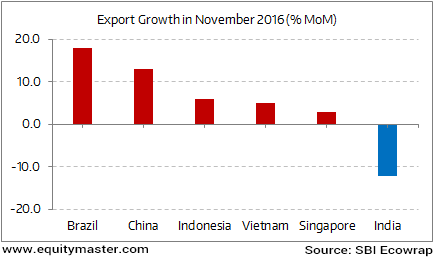Sensex Trades Marginally Higher; Realty Stocks Witness Buying
After opening the day on a flat note, the Indian share markets witnessed choppy trades and have continued to trade near the dotted line. Sectoral indices are trading on a positive note with stocks in the realty sector and IT sector witnessing maximum buying interest.
The BSE Sensex is trading up 121 points (up 0.4%) and the NSE Nifty is trading up 51 points (up 0.5%). The BSE Mid Cap index is trading up by 0.8%, while the BSE Small Cap index is trading up by 0.9%. The rupee is trading at 66.93 to the US$.
In the news from global financial markets, US retail sales rose more than expected in January and consumer prices recorded their biggest gain in nearly four years.
Data released by the Commerce Department said retail sales increased 0.4% in January. On a year-on-year basis, retail sales were up 5.6%.
On the inflation front, the US Consumer Price Index (CPI) jumped 0.6% in January. This was recorded as the largest increase since February 2013 and followed a 0.3% gain in December.
In the 12 months through January, the CPI increased 2.5%. This too was the biggest year-on-year gain since March 2012. The so-called core CPI, which excludes food and energy costs, rose 0.3% in January after increasing 0.2% in December. That lifted the YoY core CPI increase to 2.3% in January from December's 2.2% rise.
The above data has boosted prospects of an interest rate hike from the Federal Reserve next month.
The Fed has a 2% inflation target and tracks an inflation measure which is currently at 1.7%. Strengthening domestic demand coupled with firming inflation and a favorable labor market could allow the Fed to raise interest rates at least twice this year.
All eyes are now set on the upcoming Federal Open Market Committee (FOMC) meet which is scheduled on March 14-15. The meeting will decide Fed's stance on interest rates.
The Fed last hiked interest rates in December by 25 basis points, just the second hike in more than ten years.
We doubt the strength and durability of the US economic recovery since it has been driven mainly by massive doses of money printing and artificial suppression of interest rates. Hence, we also doubt the Fed's capability to further raise interest rates.
Either way, there is going to be trouble. A quick succession of rate hikes would create a massive storm in the global financial markets. But no rate hike would lay the ground for much bigger financial storms later. Sooner or later, there will be an end to easy money policies. And that will lead to some big trends. Here's Asad Dossani, editor at Profit Hunter:
- Regardless how many more times interest rates go up, one thing is clear. This is the beginning of the end of easy money. At least, the end of easy dollars (easy euros, pounds, and yen will stay with us for a while).
As per Asad, the Fed's promise of more interest rate increases will lead to the end of easy money and will create big trends that traders can profit from.
In other news, exports from India rose for the fifth month in a row in January. Data released showed that Indian exports went up 4.3% in January from a year ago to US$ 22.1 billion. The rise in exports was seen on the back of improved demand from the US, the European Union, and Japan.
The above improvement comes as a welcome breather for Indian exports that had nosedived in the months following demonetisation.
Impact of Demonetisation on India's Exports

We believe that India must be a part of global supply chains to improve its competitiveness on the export front. It also needs world class export-related infrastructure. At a time when the world is progressing more towards protectionism, India needs holistic reforms rather than jingoistic rhetoric to become the factory of the world.



